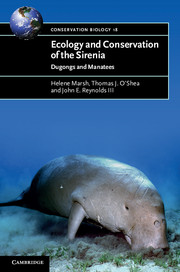Book contents
- Frontmatter
- Contents
- Foreword
- Preface
- Acknowledgements
- 1 Introduction
- 2 Steller’s sea cow
- 3 Affinities, origins and diversity of the Sirenia through time
- 4 Feeding biology
- 5 Behaviour and habitat use
- 6 Life history, reproductive biology and population dynamics
- 7 Threats
- 8 Conservation status
- 9 Conservation opportunities
- References
- List of online supplementary material
- Index
- Plate section
Foreword
Published online by Cambridge University Press: 05 January 2012
- Frontmatter
- Contents
- Foreword
- Preface
- Acknowledgements
- 1 Introduction
- 2 Steller’s sea cow
- 3 Affinities, origins and diversity of the Sirenia through time
- 4 Feeding biology
- 5 Behaviour and habitat use
- 6 Life history, reproductive biology and population dynamics
- 7 Threats
- 8 Conservation status
- 9 Conservation opportunities
- References
- List of online supplementary material
- Index
- Plate section
Summary
Foreword
On the surface of it, it seems preposterous to confuse mermaids and sirens with a 500 kg marine mammal with a face that only another sirenian might love. But knowledge and information have their own imperatives, and the more we know, the more fascinating these creatures become, and the more we are driven to protect them.
Knowledge itself is one of the tools that we can use to do that. Despite the difficulties associated with studying manatees and dugongs – they are inhabitants of turbid water, surface unpredictably and lie quietly on the bottom for long periods – researchers have pieced together much of their basic biology. Puzzles remain, however: Why do male dugongs have tusks? Is reproductive behaviour in sirenians characterised by scramble competition among males, or might they actually form mating leks? However, a rich understanding of these creatures has emerged from careful science.
- Type
- Chapter
- Information
- Ecology and Conservation of the SireniaDugongs and Manatees, pp. ix - xPublisher: Cambridge University PressPrint publication year: 2011



